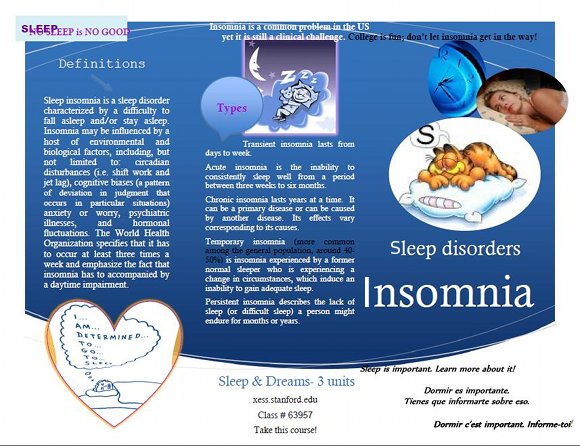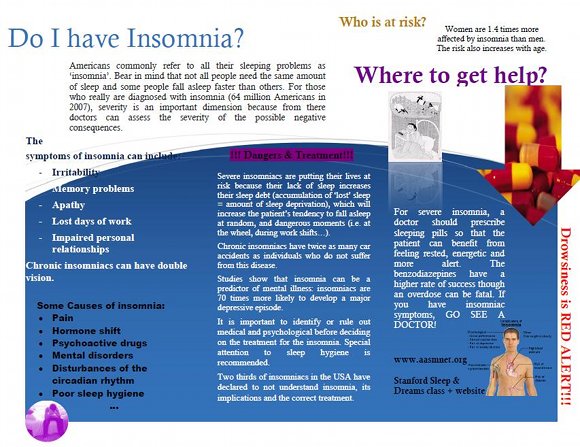
| Connect & Subscribe |
"Do I Have Insomnia?"
Informational Brochure
An Outreach Project by Vaeme Afokpa | Return To Outreach Projects 2010
The following is a brochure created for Stanford Sleep and Dreams. If it is difficult to read using the images, you may view the full text here.
Also feel free to download this brochure for distributional or general information purposes. Please refer to our privacy policy for our relevant disclaimers.


NO SLEEP is NO GOOD
Sleep insomnia is a sleep disorder characterized by a difficulty to fall asleep and/or stay asleep. Insomnia may be influenced by a host of environmental and biological factors, including, but not limited to: circadian disturbances (i.e. shift work and jet lag), cognitive biases (a pattern of deviation in judgment that occurs in particular situations) anxiety or worry, psychiatric illnesses, and hormonal fluctuations. The World Health Organization specifies that it has to occur at least three times a week and emphasize the fact that insomnia has to accompanied by a daytime impairment.
Insomnia is a common problem in the US College is fun; don't let insomnia get in the way!
Transient insomnia lasts from days to weeks.
Acute insomnia is the inability to consistently sleep well from a period between three weeks to six months.
Chronic insomnia lasts years at a time. It can be a primary disease or can be caused by another disease. Its effects vary corresponding to its causes.
Temporary insomnia (more common among the general population, around 40-50%) is insomnia experienced by a former normal sleeper who is experiencing a change in circumstances, which induce an inability to gain adequate sleep.
Persistent insomnia describes the lack of sleep (or difficult sleep) a person might endure for months or years.
Sleep is important. Learn more about it!
Dormir es importante.
Tienes que informarte sobre eso.
Dormir c'est important. Informe-toi!
Do I have Insomnia?
Americans commonly refer to all their sleeping problems as 'insomnia'. Bear in mind that not all people need the same amount of sleep and some people fall asleep faster than others. For those who really are diagnosed with insomnia (64 million Americans in 2007), severity is an important dimension because from there doctors can assess the severity of the possible negative consequences.
The symptoms of insomnia can include:
Some Causes of insomnia:
!!! Dangers & Treatment!!!
Severe insomniacs are putting their lives at risk because their lack of sleep increases their sleep debt (accumulation of 'lost' sleep = amount of sleep deprivation), which will increase the patient's tendency to fall asleep at random, and dangerous moments (i.e. at the wheel, during work shifts).
Chronic insomniacs have twice as many car accidents as individuals who do not suffer from this disease.
Studies show that insomnia can be a predictor of mental illness: insomniacs are 70 times more likely to develop a major depressive episode.
It is important to identify or rule out medical and psychological before deciding on the treatment for the insomnia. Special attention to sleep hygiene is recommended.
Two thirds of insomniacs in the USA have declared to not understand insomnia, its implications and the correct treatment.
For severe insomnia, a doctor should prescribe sleeping pills so that the patient can benefit from feeling rested, energetic and more alert. The benzodiazepines have a higher rate of success though an overdose can be fatal. If you have insomniac symptoms, GO SEE A DOCTOR!
Women are 1.4 times more affected by insomnia than men. The risk also increases with age.
About This Site
Welcome! This site is continuously being created by students of Dr. William C. Dement's Sleep And Dreams course at Stanford University.
We made this site as a call to action for people all over the world to live healthier, happier, safer, and more productive lives by learning about their own sleep. We have faith that reading the information provided on this site will motivate you to be smart about your sleep deprivation and strategic about your alertness in order to live life to your fullest, most energetic potential.
In fact, we challenge you to do so! What do you say, are you up for the challenge?
Interviews With Sleep Specialists: Insights Into the Worlds of Sleep Medicine & Sleep Business
America's Most Dangerous Disorder: What Is Sleep Apnea Doing To Your Sleep?
Sleep Debt: How Much More Will You Achieve When You Reduce Yours?
The Stages Of Sleep: The Journey Through The Night
Delayed Sleep Phase: You Want To Sleep But You're Not Tired Yet
Paralyzed at Night: Is Sleep Paralysis Normal?
Sleep In Words: Smart, Strange, and Funny Quotes About Sleep
Sleep Disorders In Children: What's Keeping Your Child From A Full Night's Rest?
Attacks of Pavor Nocturnus (a.k.a. Sleep Terrors, Night Terrors, or Incubus Attacks)
The Stanford Sleep Book
Dr. Dement's pioneering textbook has been the core text for Sleep and Dreams since 1980, but it has just recently been made available to the wider public for the first time.
In it you'll find a more detailed account of the most important things you need to know about sleep, alertness, dreams, and sleep disorders. Studies, statistics, plus plenty of Dr. Dement's classic anecdotes painting the history of sleep medicine.
Preface | Intro | Contents | Get A Copy
More Sleep Resources
The Zeo
A revolution in personal sleep tracking, the Zeo is a wireless headband that transmits your brainwaves in realtime to a dock (pictured here) or your smartphone. The result? You can wake up and see exactly what stages of sleep you were in during the night! Unprecedented personalized sleep knowledge.
Sleep Paralysis: A Dreamer's Guide
Ever woken up paralyzed? A surprising number of us have, believe it or not. But few know the actual causes of this phenomenon, and fewer still how to exert control over it. Dream researcher and sleep paralysis expert Ryan Hurd shares breakthrough insights into how to do just that.
Important Disclaimer
Please Note:
The information found on this page and throughout this site is intended for general information purposes only. While it may prove useful and empowering, it is NOT intended as a substitute for the expertise and judgments of healthcare practitioners.
For more info, see our
Terms of Use.









